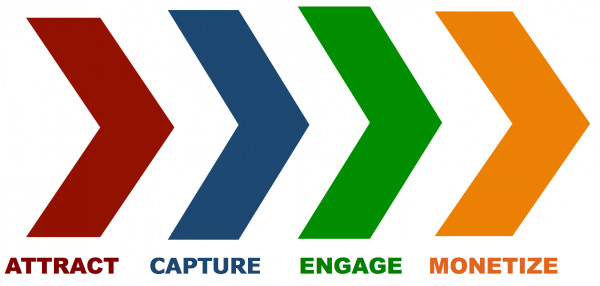A visual website architecture map to show how we get from attraction to monetization
 When we talk about our signature ACEM methodology (Attract, Capture, Engage, and Monetize) it’s easy to stop at Capture… or we’ll get to Engage and often pause there for a while, as there’s a critical acknowledgement that the process of attracting, capturing, and engaging an audience is what we must do in order to monetize subscribers and customers.
When we talk about our signature ACEM methodology (Attract, Capture, Engage, and Monetize) it’s easy to stop at Capture… or we’ll get to Engage and often pause there for a while, as there’s a critical acknowledgement that the process of attracting, capturing, and engaging an audience is what we must do in order to monetize subscribers and customers.
But monetizing is an enormous and important part of the strategy, and a website architecture map is a useful way to help explain it. We’ll get to that in a minute.
We view all four ACEM components as stand-alone strategies that must be completely interlocked in a Mequoda System. Publishers who come to us say they want more paid subscribers, and we explain that monetization doesn’t come first—it comes last.
It’s sort of like wanting fresh-squeezed orange juice of your own from scratch—first you have to prepare the soil (develop a site architecture and business plan); then plant the seed (build your site, execute the plan); attract the best sunlight and quality water, then fertilize, prune, and nurture the tree as it grows (attract, capture, and engage site visitors); and when the tree bears oranges, harvest the fruit and squeeze to get your juice (monetize)!
[text_ad]
For multiplatform publishers, you first need to increase the volume of traffic to your website from the types of people who are most likely to subscribe. You create free content that can be found in search engines, you get highly ranked in search results, and you attract new visitors to your website.
Then, you need an email subscriber base, so you have to capture those qualified website visitors as free email subscribers with a free download offering of some kind. We use 3C zone architecture to do this, which includes elements like text ads, OFIEs, and floaters to take readers from articles to conversion pages that will turn them into email subscribers (more on this later).
Then you spend time getting to know them through email, and proving that your free content is great, so it’s worth it for a free email subscriber to invest in your premium content.
Finally, you need a multiplatform magazine, so that you can more effectively convert email subscribers into monetized magazine subscribers on the platform(s) of their choosing.

Starting from the layer with the most visibility, we attract website visitors through online organic search, then, for a smaller number of those who we attract, we’ll capture their email addresses.
We will then engage an even smaller number of those captured subscribers with great content in order to keep them happy, and then make money by monetizing the relationship and turning those engaged email subscribers into buyers.
This is the smallest number of people, however, and is fueled by the layers before it. Here is a website architecture map of how ACEM works in real life:

Those bags of money at the bottom symbolize you staying in business and prospering. Strangers don’t typically just show up at your website and decide to subscribe on the spot, they need to be engaged first, through your daily emails, spotlight promotions, and week in reviews. All of these email templates should have a place to promote your magazine and other premium products.
Using our website architecture map to complete 3C zones
Consistent channel conversion zone architecture (3c), when applied to a publishing website, is a fancy way of saying that every channel (or portal topic) consistently aligns with a product that converts the user into a subscriber or paid user of your website. Together, they create what we call a zone. Using this zone to increase website-visitors-to-email conversion rates can be easy, if you let it. This metric is called your email capture rate.
Across all Mequoda client sites, the average site-wide email capture rate is 2.49%. Compare that to the industry average, which is less than .1 percent. That means, on average, 2.49% of visitors who visit a site designed with 3C zone architecture will hand over their email address to start a relationship with you. Read more about 3C Zone Architecture.
Are you looking to improve your website conversion rates? Please get in touch – we have a lot to talk about.


